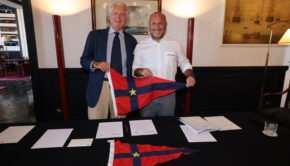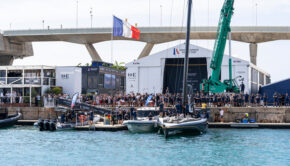On trimming the AC75’s Twin-Skin Main
Published on August 28th, 2019
Sailing World’s Dave Reed spoke with Paul Goodison, American Magic’s wing trimmer, who provided a first-hand account of the AC75s beautifully complex wing sail with lessons learned from the team’s test boat over the winter. There’s a lot going on, he says—and that’s just what’s on the surface.
How exactly does one even begin to trim a twin-skin mainsail?
It’s really unusual from any other boat where you can practically look at the sail and know how to trim it. Now, we have an independent leeward skin of the mainsail, which is the most important side to get right. The problem is, you can’t actually see it—visually. It’s like a conventional mainsail in that you have the outhaul, the cunningham and the mainsheet, but you also have an upper-panel control, which is like having a top flap on the wing that we’re able to articulate, much like we could with the AC50 [wings].
There’s a 13-foot zone at the top of the rig where we can have as many strings as we want. We can basically attach anything to the back of the rig to move that part of the sail around. There is also mast rotation to play with, which is going to be a key trimming tool.
And how do you do that?
We have several different concepts we’re trying. Some are good at moving the leech around and some are good at moving the camber around, but getting one that’s able to do both is quite a challenge because the sail shapes you’re trying to achieve from upwind to downwind are very different.
These boats have a lot more righting moment than the AC50s—and less power relative to the righting moment. A sail is never going to be as efficient as a wing with a slot between that reattaches flow, so it’s never going to be quite as powerful as a wing. So the AC75 is potentially a little underpowered relative to its righting moment. You get going quite early in the catamarans and get overpowered very quickly; with this boat, you’re searching for power and much more comfortable when sailing in 20 knots plus. It’s really cool and quite exciting.
The D-Spar is supplied equipment; what can you do to it?
The rules say the sail has to be attached on both sides. Basically the top 13 feet are the part that we can control as we wish. The bottom 6 feet or so we can control as we wish as well. Between those zones is the challenging part. A lot of it is about the batten-setup orientation, which is open in this midzone. We can change battens a lot to try different positions and tapers, which all makes a big difference. Again, the shape we want on the windward side might not be what we want on the leeward side.
Are there restrictions on batten materials?
They can’t be inflatable. They have to be able to laid flat, but can be tapered; however, there is plenty you can do there. There’s a lot of money for batten manufacturers to make this time around. – Full story
In addition to Challenges from Italy, USA, and Great Britain that were accepted during the initial entry period (January 1 to June 30, 2018), eight additional Notices of Challenge were received by the late entry deadline on November 30, 2018. Of those eight submittals, entries from Malta, USA, and the Netherlands were also accepted. Here’s the list:
Defender:
• Emirates Team New Zealand (NZL)
Challengers:
• Luna Rossa (ITA) – Challenger of Record
• American Magic (USA)
• INEOS Team UK (GBR)
• Malta Altus Challenge (MLT) – WITHDRAW
• Stars & Stripes Team USA (USA)
• DutchSail (NED) – WITHDRAW
Of the three late entries, only Stars+Stripes USA remains committed, but they still must complete the entry fee payment process before they will be eligible to race. They have already paid their initial payment but as a late entry challenger under the Protocol they also have a liability to pay a US$1million late entry fee due in installments by October 1, 2019. This deadline coincides with the venue schedule which has the construction of their team base beginning in late 2019, which we assume was done in the event the team is unable to fulfill their payment deadline.
Key America’s Cup dates:
✔ September 28, 2017: 36th America’s Cup Protocol released
✔ November 30, 2017: AC75 Class concepts released to key stakeholders
✔ January 1, 2018: Entries for Challengers open
✔ March 31, 2018: AC75 Class Rule published
✔ June 30, 2018: Entries for Challengers close
✔ August 31, 2018: Location of the America’s Cup Match and The PRADA Cup confirmed
✔ August 31, 2018: Specific race course area confirmed
✔ November 30, 2018: Late entries deadline
✔ March 31, 2019: Boat 1 can be launched (DELAYED)
✔ 2nd half of 2019: 2 x America’s Cup World Series events (CANCELLED)
October 1, 2019: US$1million late entry fee deadline
February 1, 2020: Boat 2 can be launched
April 23-26, 2020: First America’s Cup World Series event in Cagliari, Sardinia.
During 2020: 3 x America’s Cup World Series events
December 10-20, 2020: America’s Cup Christmas Race
January and February 2021: The PRADA Cup Challenger Selection Series
March 2021: The America’s Cup Match
Details: www.americascup.com









 We’ll keep your information safe.
We’ll keep your information safe.